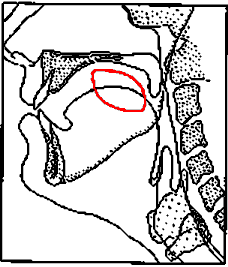Glides
Many of the parameters for consonants are also relevant for vowels (e.g.,
state of the glottis, nasality). Even the basic constriction parameters
can be relevant:
- active articulator
- passive articulator
- constriction degree
Since vowels are partly defined by the highest point reached by the
tongue body, it makes sense to think of the tongue body as the active
articulator. For high vowels, the tongue body is narrowing the vocal
tract, so it makes sense to ask what passive articulator the narrowing is
closest to and what the degree of constriction is.

For high front vowels, the tongue body approaches the hard palate. For
high back vowels, the tongue body approaches the soft palate. The vocal
tract is narrowed, but not so much as to cause the airflow to become
turbulent -- so the degree of constriction is approximant.
If we wanted to use the consonant parameters for [i] and [u], we would
have to say:
- [i] is a dorso-palatal approximant
- [u] is a dorso-velar approximant
But we already have a dorso-palatal approximant -- [j]. We already
have a dorso-velar approximant as one half of [w] (it also occurs alone in
many languages and is represented by [ ]).
]).
In fact, the tongue body positions can be the same for [i] and [j].
The only difference is in whether the sound is acting like a vowel
(standing in the centre of a syllable) or like a consonant (standing near
the edges of a syllable). Glides are vowels masquerading as consonants.
A [j] isn't necessarily exactly like [i] -- English only seems to care
that the tongue position is somewhere in the high or upper mid region:
- [j] = [i] / [
 ]
/ [e]
]
/ [e]
- [w] = [u] / [
 ]
/ [o]
]
/ [o]
For any dorsal approximant acting as a consonant, we could be very precise
about the position of the tongue body by using the appropriate vowel
symbol -- we could emphasize the fact that it's acting like a consonant by
putting a semicircle (the diacritic meaning "non-syllabic") under the
vowel. In a broader transcription, we usually want to ignore details like
these and simply use [j] or [w] as a cover symbol.
Next: Diphthongs
Previous: Other vowel parameters
Up: table of contents


 ]).
]).
 ]
/ [e]
]
/ [e]
 ]
/ [o]
]
/ [o]